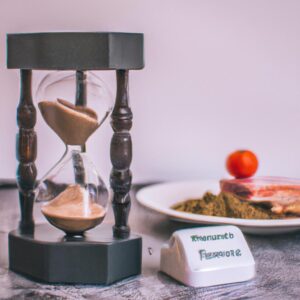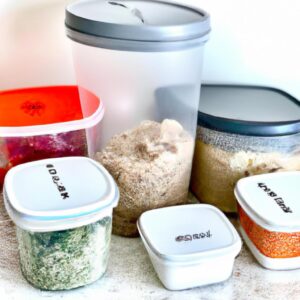Unlock the Secrets to Healthy Eating by Reading Food Labels

Introduction: Reading Food Labels for Healthier Eating
Food labels provide important information about the food we purchase and can help us make healthier choices. This guide will help you understand what to look for when reading food labels, so that you can make choices that are better for your health.
Understanding food labels can be confusing because of all the symbols and terms used on packaging. This guide will explain how to read and interpret food labels, so that you can make informed decisions about the foods you buy.
The goal of this guide is to teach you about the key concepts related to food labels and healthy eating. After reading this guide, you will be able to identify the information on a nutrition facts label, ingredient list and other food labels. You will also understand what to look for on the front of food packaging, the meaning of common labeling terms, nutrition claims and endorsements, and more.
Benefits of Reading Food Labels
Reading food labels can be an important part of making healthier eating choices and living a healthier lifestyle. Not only can reading food labels help you make healthier choices, but it can also give you an understanding of the nutritional content that you’re putting into your body.
One of the most important advantages of reading food labels is that it can help you choose foods with fewer calories and fats. This is important if you’re trying to lose weight or maintain a healthy diet. By understanding the nutritional information on food labels, you’ll be able to make better decisions about which foods to eat and which to avoid.
Food labels can also provide helpful information about ingredients that can trigger food allergies or other sensitivities. This can be especially beneficial for people who have food allergies or other conditions that require them to avoid certain foods. By understanding which ingredients are used in the foods you eat, you’ll be able to make more informed choices.
Reading food labels can also help you ensure that you’re getting all of the essential nutrients your body needs. By understanding the nutritional content of the foods you’re eating, you can make sure you’re getting enough of the vitamins, minerals, proteins, and other nutrients that your body needs.
Finally, reading food labels can help you identify key elements such as the calorie and fat content of a food item, which can be beneficial for everyone trying to make healthier eating choices.
What to Look for on the Front of Food Packaging?
When grocery shopping, it’s easy to be overwhelmed by the vast amount of food choices. To make informed decisions about what you buy and eat, you should take a few moments to read food labels. While the ingredients list and nutrition facts label are the two most important pieces of information to consider, there is additional information located on the packaging that can provide valuable insights.
The front of food packaging often contains nutritional claims. These are statements used to help consumers make decisions about food choices. Examples include “low fat”, “light”, “organic”, “no sugar added”, and “high in fiber”. Generally, claims refer to one single nutrient, like fat or sugar. It’s important to look at the nutrition facts label and the ingredients list to get a better understanding of the product as a whole.
Front-of-pack labels may also contain Heart Foundation ticks or logos. The Heart Foundation Tick is a symbol used to indicate that the food is healthier in some way, when compared with similar foods. It is important to note that the presence of this logo does not guarantee a healthy product; however, it can be a useful tool when choosing between products.
Serving sizes are also found on the front of packages. A serving size is a reference amount of food, such as a cup or number of pieces, which is used to calculate the nutrition information listed on the package. It is important to note that the caloric content listed on the nutrition facts label is based off the serving size and not the entire product. Therefore, if you eat twice the listed serving size, you are also consuming twice the amount of calories, fat, carbohydrates, and other nutrients.
Remember, food labels provide essential information to help you make informed food decisions. Looking at the front of food packaging is an easy way to quickly identify which product best aligns with your nutritional needs.
Identifying the Nutrition Facts Label
The nutrition facts label is one of the most important parts of food packaging. It provides detailed information about the amount of calories, fat, sodium, fiber, and other nutrients a product contains. This makes it easy to compare similar products and determine which one is healthier.
The nutrition facts label is located on the back of a packaged food item, usually close to the bottom. It typically looks like a box with black and white text, but the exact layout can vary depending on the product. The label includes a list of the nutrients per serving size as well as the total number of servings. The label will also include a list of ingredients so you can check for potential allergens or undesirable additives.
Reading the nutrition facts label gives you an overall picture of a product’s nutritional value. For example, if a product is labeled as “low-fat”, you can use the label to see how much fat it actually contains. The label will also indicate any added sugar or preservatives, helping you make better-informed decisions when shopping for food.
Using the nutrition facts label for healthier choices
The nutrition facts label is a great way to help understand what’s in your food and make healthier choices. It’s usually located on the back or side of the packaging, and looks like a box with lots of numbers and information inside. The nutrition facts label provides the following information:
- Serving size
- Calories
- Total fat
- Saturated fat
- Trans fat
- Cholesterol
- Sodium
- Total carbohydrates
- Fiber
- Sugars
- Protein
- Vitamins and other minerals
By understanding what the different values in the nutrition facts label mean, you can make better decisions about which foods are healthier for you. For example, pay attention to the serving size, as that’s how all the numbers in the label are calculated. If the serving size is one cup and you eat two cups, you need to double all the values in the label.
Also, when it comes to nutrition, it’s important to look at the total amount of fat, saturated fat, and trans fat, as well as the types of sugars included in the food. Generally, it’s best to look for a product that has less than 5% of your daily value for these categories, and avoid any food with added sugars. Lastly, aim for foods that have plenty of fiber, vitamins, and minerals.
Understanding Labeling Terms
Food labeling terms are designed to help us make smarter and healthier decisions about the foods we eat. Some terms you may have seen when looking at food labels include “low-fat” or “high-fiber.” But what do those words actually mean?
“Low-fat” products are food items that have 3 grams or less of fat per serving. Foods labeled “low-fat” can still contain some fat, so it’s important to read the nutrition facts label to determine how much fat the product contains. Low-fat foods can be helpful if you’re trying to watch your fat intake.
“High-fiber” foods are products that contain 5 grams or more of fiber per serving. Fiber helps keep us regular and can also help us feel full with less food. Eating more high-fiber foods can also help reduce the risk of developing certain diseases like diabetes and heart disease. Look for foods with high-fiber content if you’re trying to increase your intake of fiber.
Understanding the Ingredients List
The ingredients list is usually found on the side or back of a food product and it contains all the information you need to make an informed decision about what you are eating. It is a legal requirement for manufacturers to include an accurate list of ingredients on every product, with the ingredients listed in order of weight.
When examining the ingredients list, keep an eye out for the following:
- Processed Foods: Highly processed foods often contain extra sugar, preservatives, artificial colors, and other unhealthy additives. If you’re trying to make healthier choices, look for products that contain fewer processed ingredients.
- Sodium: A high amount of sodium is bad for your health, so try to limit your intake. Look for products that have fewer than 140mg of sodium per serving.
- Trans Fats: Trans fats are unhealthy and can contribute to heart disease and other issues. Avoid products that contain trans fats, which are usually labeled as “partially hydrogenated oils”.
- Added Sugar: Look for products that contain no added sugar or, if possible, natural sweeteners like honey and maple syrup.
- Whole Grains: Whole grains are an important part of a healthy diet. Look for products that contain whole grains like wheat, oats, and brown rice.
By understanding the ingredients list, you can make more informed decisions about the foods you buy and ultimately pave the way for a healthier lifestyle.
Reading “Use By” and “Best Before” Dates
Understanding the difference between a “use by” and a “best before” date can help you make more informed decisions about the food you buy, and keep your food fresher for longer. The “use by” date is the last day a food should be eaten for safety reasons. If the food is consumed after this date, there is an increased risk of food poisoning. On the other hand, the “best before” date is an indication of quality. Even after the date has passed, food can still be safe to eat; however, it may not taste as good.
It is important to check these dates when shopping for groceries, as the food may not be of the same quality or safe to eat if bought after the date indicated. Also, look out for any special storage instructions on the packaging: some foods need to be kept in the refrigerator, whereas others may require freezing.
What’s the Difference Between Nutrition Claims and Endorsements?
Nutrition claims and endorsements can both be found on food packaging labels, but they mean two very different things. A nutrition claim is an indication that the food product contains a nutrient or ingredient that has been shown to have health benefits. On the other hand, an endorsement is an outside source providing their opinion on the food product.
Nutrition claims typically must meet certain criteria to be allowed on food packaging. For instance, if a product is labeled as having “no added sugar,” that claim must be backed up by scientific evidence. Companies are responsible for ensuring that the claims on their products are true and accurate.
Endorsements, meanwhile, are not restricted to particular criteria. An endorsement is when someone, such as a celebrity chef, endorses a product because they believe it is tasty or beneficial in some way. Endorsements are generally subjective and should not be taken as scientific fact.
How to Read Food Labels Quickly and Correctly
Reading food labels can be overwhelming, but it is important to be aware of what is going into your body. Knowing how to read and interpret food labels correctly can help you make healthier choices that will benefit you and your family. Here are some tips to help you do just that:
- Scan the label for key terms. The first ingredient listed on a food label is the most prominent ingredient, so keep an eye out for that and any other language that might indicate the food is not healthy. Words like trans fat, hydrogenated oil, and high fructose corn syrup should all sound alarm bells.
- Check for serving size information. This is often found near the top of the label and will help you understand how much of the product is actually in each serving, so you can accurately calculate the nutrition information for the amount you intend to eat.
- Review the nutrition facts label. The nutrition facts label will give you a breakdown of the calories, fat, sodium, carbohydrates, and other nutrients contained in one serving of the food. You can use this information to compare different products and select the healthier option.
- Pay attention to terms such as “low-fat” or “high-fiber.” These terms have specific meaning and the FDA has set a minimum threshold for food to be considered low-fat, high-fiber, etc. When looking at these terms, check the nutrition facts label for the actual amounts of fat, fiber, and other nutrients.
By taking the time to read and understand the food label, you can make better decisions about what to put into your body. Becoming familiar with the key terms, understanding what portion sizes are, and learning how to interpret the nutrition facts label will all help you make healthier choices when it comes to food.
How Food Labels Help Children Make Healthier Choices
Food labels can be a great resource for children of all ages to understand what is in their food and why it is important. By reading labels, children can learn about calories, serving sizes, and nutrition facts, as well as how to make healthier decisions when they shop and eat.
The nutrition facts label on the front of food packages can help children learn what foods contain and how much of each nutrient they should have per serving. It is a good idea to teach children to look at total fat, saturated fat, cholesterol, sodium, carbohydrates, fiber, and sugar content first. Parents and caregivers can also explain various nutrients into “good” and “bad” categories, so that children can easily identify which foods are healthier for them.
Children should learn how to use the information found in the ingredients list. They should learn to recognize common unhealthy ingredients such as high fructose corn syrup, partially hydrogenated oils, and artificial flavors and colors. By learning to recognize these ingredients, children can become food label savvy shoppers.
Finally, children should learn how to read food labels in order to identify expiration dates. Many foods have “use by” or “best by” dates that signify when food should be consumed by for optimal freshness. This information can help them make sure they are eating food that has not expired.
By understanding food labels, children can become more aware of the food choices available to them. This can help them make more informed decisions when it comes to what they eat and lead to healthier, more nutritious meals.
Conclusion
Reading food labels is a great way to make healthier eating choices. By understanding the different components of labels, nutrient content and labeling terms, you can learn how to choose foods that are better for you and your family. It’s important to read nutrition facts labels and ingredients lists carefully in order to make informed decisions about which foods to eat. When looking at the front of packaging, watch out for nutritional claims and endorsements, as they don’t always tell the whole story. Finally, remember to check the expiration date on food products to make sure it is still safe and healthy to consume.
By following the steps outlined in this guide, you can be sure to make better decisions when it comes to food shopping and meals. Translating food labels to make the right choices can be tricky, but we hope this guide has helped you understand what the information on food labels means and how it can help you make healthier eating habits.
comments: 0





